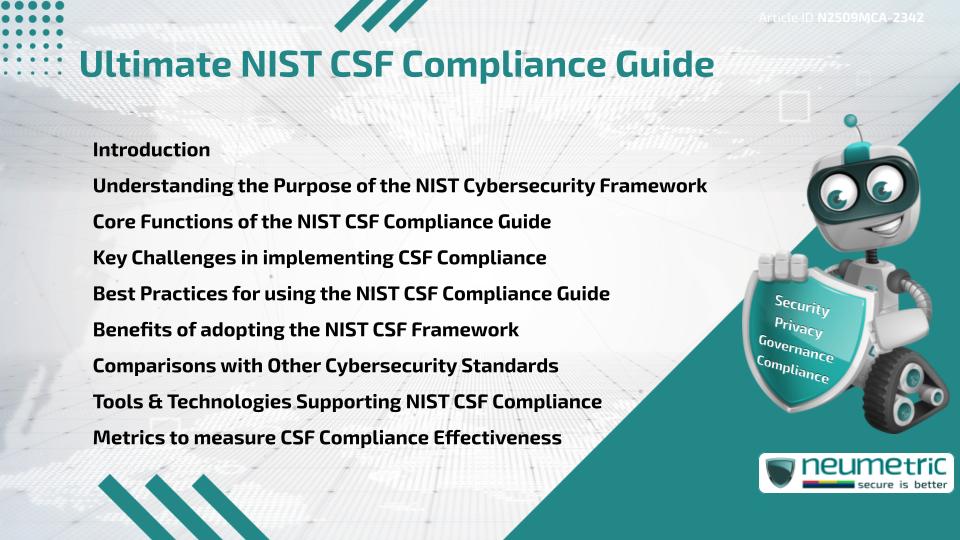Table of Contents
ToggleIntroduction
The NIST CSF Compliance Guide is a practical Roadmap for Organisations seeking to improve Cybersecurity posture & manage Risks effectively. Developed by the National Institute of Standards & Technology [NIST], the Cybersecurity Framework [CSF] provides a flexible, Risk-based approach that can be applied across Industries. It helps Organisations Identify, Protect, Detect, Respond & Recover from Cyber Threats while aligning with Global Best Practices.
Understanding the Purpose of the NIST Cybersecurity Framework
The NIST CSF was designed to strengthen critical Infrastructure Protection in the United States but has since been widely adopted by Organisations worldwide. Its purpose is to provide a common language for managing Cybersecurity Risk, promote Collaboration across Stakeholders & support Regulatory Compliance. The official Framework is available from the NIST Cybersecurity Framework site.
Core Functions of the NIST CSF Compliance Guide
The NIST CSF Compliance Guide is structured around five (5) Core Functions:
- Identify: Understand Assets, Risks & Vulnerabilities.
- Protect: Implement Safeguards such as Access Controls & Awareness Training.
- Detect: Develop Monitoring Tools to identify Anomalies & Incidents.
- Respond: Establish procedures to contain & mitigate Incidents.
- Recover: Plan for resilience & timely restoration of Services.
These functions provide a comprehensive lifecycle approach to Cybersecurity Management.
Key Challenges in implementing CSF Compliance
Organisations often face hurdles such as:
- Limited Resources to implement & monitor Controls.
- Difficulty tailoring the Framework to unique Business Environments.
- Challenges in integrating CSF with existing Governance Models.
- Lack of Skilled Personnel for effective Deployment.
- Measuring performance & improvements consistently.
These challenges underscore the importance of structured Planning & incremental Adoption.
Best Practices for using the NIST CSF Compliance Guide
To effectively adopt the NIST CSF Compliance Guide, organisations should:
- Conduct a current-state Assessment to identify Gaps.
- Prioritise improvements based on Risk & Impact.
- Map CSF Controls to existing Regulatory requirements.
- Leverage automation for Monitoring & Incident Detection.
- Regularly update Frameworks to align with emerging threats.
Implementation guidance is also available from ISACA.
Benefits of adopting the NIST CSF Framework
Organisations that align with the NIST CSF Compliance Guide gain:
- Improved Cybersecurity resilience & preparedness.
- Enhanced Governance & Accountability in Risk Management.
- Stronger alignment with Regulators & Industry Standards.
- Increased Stakeholder Trust through Transparency.
- Competitive advantage as a Security-focused Organisation.
Comparisons with Other Cybersecurity Standards
Compared with ISO 27001, the NIST CSF is more flexible & Risk-based, allowing adaptation for Organisations of different sizes. While NYDFS Regulations or APRA CPS 234 are legally binding, the NIST CSF Compliance Guide serves as a voluntary but widely respected Framework.
Tools & Technologies Supporting NIST CSF Compliance
Organisations can use tools such as Governance, Risk & Compliance [GRC] platforms, Security Information & Event Management [SIEM] solutions, Vulnerability Scanners & Endpoint Detection Systems to support Compliance. Technical resources are also available in the NIST Risk Management Framework.
Metrics to measure CSF Compliance Effectiveness
Key performance indicators include:
- Percentage of Assets inventoried & classified.
- Mean time to detect & respond to Incidents.
- Number of training sessions delivered to Staff.
- Frequency of Vulnerability Assessments conducted.
- Audit outcomes & Regulator feedback on Cybersecurity posture.
Takeaways
- Provides a flexible, Risk-based approach to managing Cybersecurity.
- Covers five (5) Core Functions: Identify, Protect, Detect, Respond, Recover.
- Aligns with Regulatory Standards while remaining voluntary.
- Enhances Governance, Accountability & Stakeholder Trust.
- Supports resilience against evolving Cyber Threats.
- Can be tailored for Organisations of any size & sector.
- Encourages Continuous Improvement through Metrics & Audits.
FAQ
What is the NIST CSF Compliance Guide?
It is a Roadmap for aligning Cybersecurity practices with the NIST Cybersecurity Framework.
Is NIST CSF mandatory?
No, it is voluntary, but many Regulators & Industries use it as a benchmark.
Who should use the NIST CSF?
Any Organisation seeking to improve Cybersecurity Risk Management, regardless of size or industry.
How does the CSF compare to ISO 27001?
CSF is more flexible & Risk-based, while ISO 27001 is a certifiable Standard with stricter requirements.
What are the five Core Functions of the NIST CSF?
Identify, Protect, Detect, Respond & Recover.
Can Small Organisations implement NIST CSF?
Yes, its flexibility makes it suitable for both Small & Large Organisations.
How is Compliance measured?
Through Assessments, Gap analyses & Performance metrics aligned with CSF functions.
Need help for Security, Privacy, Governance & VAPT?
Neumetric provides organisations the necessary help to achieve their Cybersecurity, Compliance, Governance, Privacy, Certifications & Pentesting needs.
Organisations & Businesses, specifically those which provide SaaS & AI Solutions in the Fintech, BFSI & other regulated sectors, usually need a Cybersecurity Partner for meeting & maintaining the ongoing Security & Privacy needs & requirements of their Enterprise Clients & Privacy conscious Customers.
SOC 2, ISO 27001, ISO 42001, NIST, HIPAA, HECVAT, EU GDPR are some of the Frameworks that are served by Fusion – a SaaS, multimodular, multitenant, centralised, automated, Cybersecurity & Compliance Management system.
Neumetric also provides Expert Services for technical security which covers VAPT for Web Applications, APIs, iOS & Android Mobile Apps, Security Testing for AWS & other Cloud Environments & Cloud Infrastructure & other similar scopes.
Reach out to us by Email or filling out the Contact Form…


